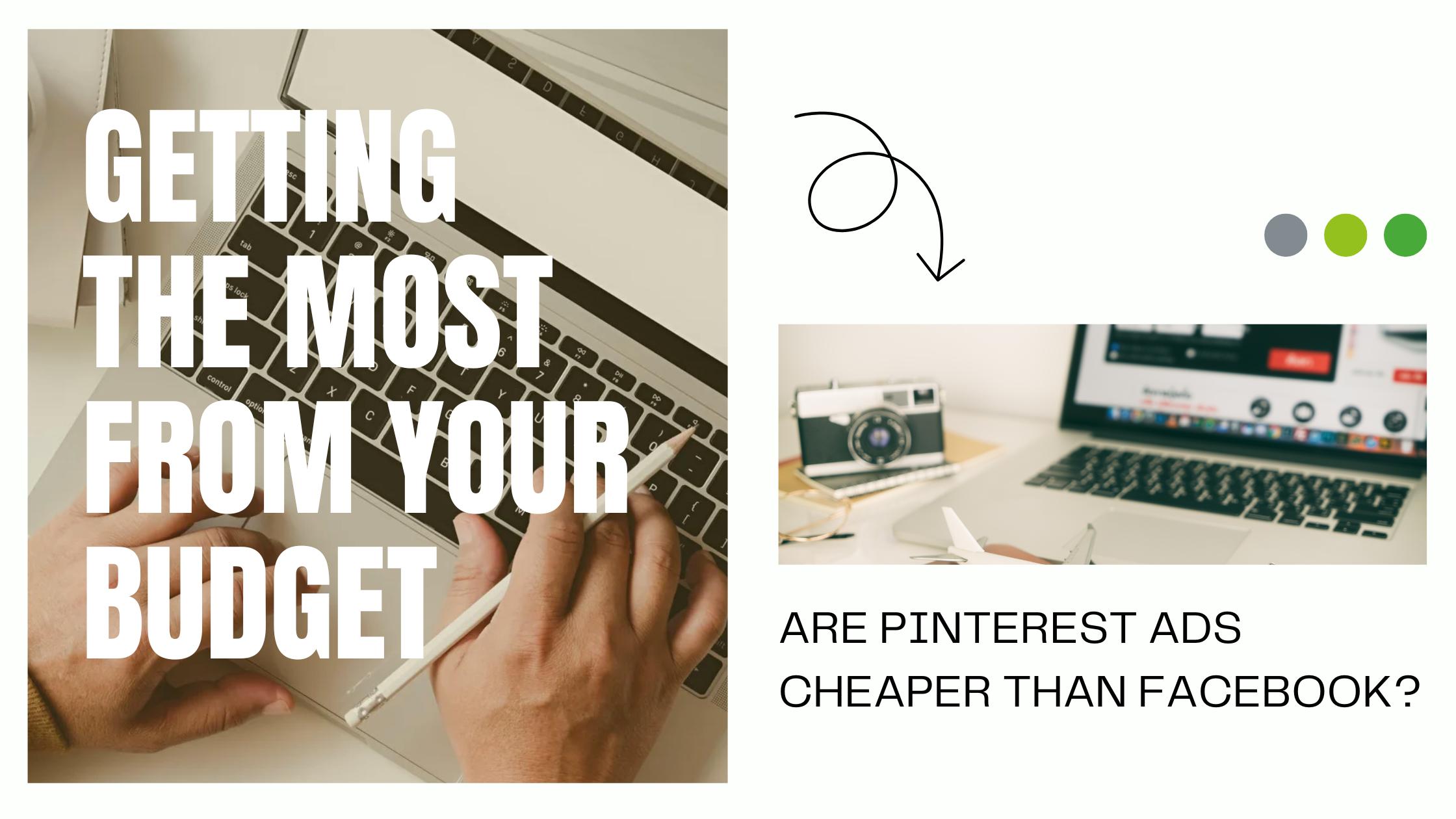Maximise your ad spend with insights on Pinterest vs Facebook ad costs and effectiveness.
Quick Answer:
Pinterest ads can be cheaper than Facebook, particularly for CPC rates, making them attractive for driving website traffic. However, Facebook’s extensive reach and targeting options may provide better value for a diverse audience.
Key Takeaways:
- Pinterest ads can offer lower cost-per-click (CPC) rates, making them a potentially more budget-friendly option for driving website traffic, while Facebook’s larger user base may result in higher cost-per-mille (CPM) rates but provides extensive reach and detailed targeting options.
- Both platforms have robust targeting capabilities, with Pinterest excelling in visual search and interest-based targeting, and Facebook offering advanced behavioural targeting, which can lead to higher conversion rates despite potentially higher costs.
- The effectiveness of ad spend on Pinterest versus Facebook is contingent on aligning ad formats and creative strategies with campaign objectives, and continuously monitoring and adjusting campaigns based on performance data to maximise return on investment (ROI).
When it comes to advertising on social media, understanding the cost structure is crucial for making the most of your marketing budget. Both Pinterest and Facebook offer unique advantages, but their costs can vary based on several factors. These include bidding strategies, ad quality, and audience targeting. Each of these elements plays a role in determining how much you’ll pay and the value you’ll get in return.
Evaluating the Cost-Effectiveness of Pinterest Ads vs. Facebook Ads
Understanding the Cost Structure of Pinterest Advertising
Pinterest stands out with its visual search capabilities and the option to promote pins. The platform’s cost structure is influenced by bid types and ad formats. For instance, you can opt for cost-per-click (CPC) or cost-per-engagement (CPE) bidding, depending on your campaign goals. Additionally, seasonal trends can affect pricing, with certain times of the year being more competitive due to higher demand.
Businesses can leverage Pinterest’s pin promotion to boost visibility for their products. This is especially effective for brands with a strong visual appeal. By targeting users who are actively searching for inspiration, companies can enhance their ad’s performance and, potentially, enjoy a better return on their investment.
Breaking Down the Costs of Facebook Advertising
On the other hand, Facebook’s advertising costs are determined by factors such as the ad relevance score, competition within the ad auction, and ad placement. A higher relevance score can lead to lower costs and better ad performance. The platform’s detailed targeting options are also pivotal. They allow you to reach a specific audience, which can greatly improve the efficiency of your ad spend.
Understanding these components is essential for businesses looking to make the most of their budget on Facebook. By crafting high-quality ads and choosing the right targeting options, you can increase the likelihood of your ad resonating with your audience, which can lead to lower costs and higher engagement.
Direct Cost Comparison: CPC and CPM Rates
Comparing the average CPC and CPM rates between Pinterest and Facebook can offer insights into which platform may be more cost-effective for your business. Generally, Pinterest tends to have lower CPC rates, making it an attractive option for businesses aiming to drive traffic to their site. Facebook, with its vast user base, might have higher CPM rates but offers extensive reach.
These metrics are vital for guiding businesses on where to allocate their advertising budget for the best return on investment. It’s important to consider not just the cost, but also the quality of the interactions and the potential for conversion.
Budget Allocation: How to Distribute Your Ad Spend
Deciding how to split your ad spend between Pinterest and Facebook should align with your business goals, target audience, and desired outcomes. If your target audience spends more time on Pinterest and responds well to visual content, allocating a larger portion of your budget there could be wise. Conversely, if your audience is broader and more diverse, Facebook’s extensive targeting options might offer better value.
The key is to test and measure ad performance across both platforms. This approach allows you to see which platform gives you the best engagement and conversion rates for your investment. Over time, you can refine your strategy to ensure that every penny of your ad spend is working hard for your business.
By carefully considering each platform’s cost structure and how it aligns with your marketing objectives, you can make informed decisions that maximise your budget’s effectiveness. Whether Pinterest ads are cheaper than Facebook will depend on your specific circumstances, but with the right strategy, both can offer significant value for money.
Analysing Advertising Performance and ROI
To truly understand the value of your advertising efforts on Pinterest and Facebook, it’s not just about how much you spend, but what you get back in return. This is where the concept of return on investment (ROI) comes into play. By setting clear performance goals and interpreting the resulting data, you can make decisions that enhance the cost-effectiveness of your campaigns.
Measuring Success: Key Performance Indicators (KPIs) to Monitor
To gauge the success of your ads, certain KPIs are essential:
- Engagement Rates: How often are people interacting with your ads?
- Lead Generation: Are your ads bringing in potential customers?
- Sales Conversions: Ultimately, are the ads leading to sales?
These indicators will help you understand if your investment is translating into tangible results. For instance, high engagement rates on Pinterest might indicate strong interest in your content, while solid sales conversions on Facebook could show that your ads are effectively driving purchases.
Click Through Rate (CTR) and Conversion Rate Benchmarks
Benchmarks for CTR and conversion rates provide a standard to measure your ads against:
- Pinterest often sees an average CTR of around 0.2% to 0.5%, while Facebook can vary widely, often ranging from 0.5% to 1.6%.
- Conversion rates can be trickier to pin down, as they depend heavily on industry and ad quality, but a good benchmark for Facebook is around 9.21% for retail.
Factors influencing these rates include the quality of your ad creative, the relevance to your target audience, and the clarity of your call-to-action. To improve them, consider A/B testing different ad elements and refining your targeting criteria.
Return on Ad Spend (ROAS) and Return on Investment (ROI) Insights
ROAS and ROI are the metrics that tell you whether your ad spend is working hard enough:
- ROAS measures the gross revenue generated for every pound spent on advertising.
- ROI takes it a step further by considering the net profit after ad costs.
Calculating these metrics involves tracking the revenue or profit generated from your ads and comparing it to the cost of running them. For example, if you spend £500 on Pinterest ads and generate £1,500 in sales, your ROAS is 3:1. However, after subtracting the cost of goods sold and other expenses, your ROI might be lower.
By keeping a close eye on these metrics, you can determine which platform is giving you the best return and adjust your strategies accordingly. Whether Pinterest ads are more cost-effective than Facebook will depend on how well they meet your specific business objectives and how efficiently they turn browsers into buyers.
Targeting Capabilities and Audience Engagement
The secret to maximising your ad spend lies in the ability to zero in on your ideal customer. Both Pinterest and Facebook offer robust targeting options that can help you engage with specific audience segments. The precision of your targeting can significantly influence your ad costs and the quality of engagement you receive.
Demographic Targeting: Reaching Your Ideal Customer
Demographic targeting is a powerful tool on both platforms, allowing you to connect with users based on age, gender, location, and more. Here’s how it can work to your advantage:
- Pinterest and Facebook provide access to a wealth of demographic data.
- You can tailor your ads to resonate with the life stage and interests of your audience.
- A well-defined audience can lead to higher engagement and cost savings.
By focusing your ads on the people most likely to be interested in your products, you’re not just saving money—you’re also boosting the potential for genuine engagement.
Interest-Based Targeting on Pinterest and Its Impact on Engagement
Pinterest excels with its interest-based targeting capabilities:
- Users can be targeted based on the types of pins they interact with or the searches they perform.
- Pin interest and search keywords help deliver your ads to users who are already inclined towards your niche.
- This relevance can lead to higher ad engagement and more cost-effective campaigns.
By tapping into what users are already looking for, you can craft campaigns that feel more like a natural discovery rather than a hard sell.
Behavioural Targeting on Facebook and Conversion Potential
Facebook takes targeting a step further with its behavioural targeting:
- Ads can be shown to users based on their past actions, like previous purchases or website visits.
- User actions and purchase history provide insights that can be used to predict future buying behaviour.
- This granular level of targeting can significantly enhance conversion potential.
While this might come at a higher cost, the ability to reach users who have already shown an interest in similar products can lead to a better ROI.
In conclusion, both Pinterest and Facebook offer distinct targeting capabilities that can help you engage with your audience more effectively. By understanding and utilising these features, you can potentially lower your ad costs while increasing the quality of engagement—a crucial balance for getting the most from your budget.
Ad Formats and Creative Strategies for Maximum Impact
Choosing the right ad formats and creative strategies is essential to make a splash with your campaigns. Both Pinterest and Facebook offer a suite of options, each with its own potential for impact and cost implications. Aligning these formats with your campaign objectives is key to getting the most from your budget.
Exploring the Variety of Ad Formats Available on Pinterest
Pinterest provides a canvas for creativity with several ad formats:
- Promoted Pins are the standard format, blending seamlessly into the user’s feed.
- Carousel Ads allow multiple images for users to swipe through, ideal for showcasing a range of products.
- Video Ads capture attention with motion and sound, perfect for storytelling.
Selecting the most cost-effective format depends on your goals:
- Use Promoted Pins for broad reach and brand awareness.
- Opt for Carousel Ads when you want to highlight several aspects of your product or service.
- Choose Video Ads to make a strong impression or demonstrate your product in action.
Each format can influence engagement and cost, so it’s important to match your choice to your objectives.
Leveraging Facebook’s Diverse Ad Types for Your Campaigns
Facebook offers a rich array of ad types to meet diverse campaign needs:
- Image Ads are straightforward and effective for quick messages and strong visuals.
- Video Ads can be highly engaging and are favoured in Facebook’s algorithm.
- Carousel Ads let you showcase multiple products or tell a story across cards.
- Slideshow Ads provide a video-like experience that’s less resource-intensive.
To achieve high engagement at a lower cost:
- Use Image Ads for simplicity and cost-effectiveness.
- Leverage Video Ads for maximum engagement, especially if your audience consumes a lot of video content.
- Employ Carousel Ads for storytelling or to highlight multiple offerings.
- Opt for Slideshow Ads if you’re targeting regions with slower internet connections or want to repurpose existing images creatively.
Remember, creative optimisation is crucial for each ad type to resonate with your audience.
Creative Best Practices for Eye-Catching Ads
Creating ads that catch the eye and engage the audience is both an art and a science. Here are some best practices for both Pinterest and Facebook:
- Use high-quality visuals that stand out in the feed.
- Craft compelling copy that speaks directly to your audience’s needs and desires.
- Include a clear call-to-action (CTA) to guide users on what to do next.
These elements are the cornerstone of improving ad performance. Higher engagement driven by top-notch creative work can lead to better ad placements and potentially lower costs.
By mastering ad formats and creative strategies, you can create campaigns that not only resonate with your audience but also align with your budgetary constraints. Whether Pinterest ads are more affordable than Facebook may depend on how well you utilise these formats and strategies to meet your campaign goals.
Practical Steps to Launch and Optimise Your Ad Campaigns
To ensure your ad campaigns are not just up and running but also fine-tuned for performance, it’s vital to embrace a cycle of launching, monitoring, and adjusting. This approach keeps your campaigns aligned with your business objectives and helps you get the most from your budget on platforms like Pinterest and Facebook.
Setting Up Your First Pinterest Ad Campaign: A Step-by-Step Guide
Launching an ad campaign on Pinterest can be a game-changer for your business. Here’s how to get started:
- Define your campaign goal, whether it’s increasing brand awareness, driving traffic to your website, or boosting sales.
- Choose the right ad format that aligns with your goal, such as Promoted Pins for awareness or Video Ads for engagement.
- Use targeting options to hone in on your desired audience, considering factors like demographics, interests, and behaviours.
- Set a budget that reflects your campaign’s scale and duration, starting small to test the waters if necessary.
Once your campaign is live, use performance data to make informed decisions:
- Analyse which pins are performing best and why.
- Adjust your targeting to better match your audience’s preferences.
- Reallocate your budget to the most effective ads and formats.
Launching a Successful Facebook Ad Campaign: Key Considerations
Facebook offers a diverse landscape for advertisers. To launch a successful campaign:
- Get to grips with the ad platform interface. Take advantage of Facebook’s resources to understand the dashboard and tools available.
- Select the ad format that will best convey your message, whether it’s a simple Image Ad or a dynamic Carousel Ad.
- Set realistic budgets based on your campaign goals and the audience you want to reach.
Leverage Facebook’s analytics tools to track your campaign’s performance:
- Monitor metrics like reach, engagement, and conversion rates.
- Use A/B testing to compare different ad elements and find what works best.
- Optimise your spend by focusing on ads that deliver the highest ROI.
Monitoring and Adjusting Your Campaigns for Improved Results
The key to a cost-effective campaign is ongoing monitoring and adjustment. Here’s how to stay on top of your campaigns:
- Regularly check your analytics reports on both Pinterest and Facebook to understand how your ads are performing.
- Make data-driven adjustments to your campaigns based on these insights. This could involve tweaking your ad copy, refining your targeting, or shifting your budget to better-performing ads.
- Don’t be afraid to pause underperforming ads and test new ideas.
By staying agile and responsive to the data, you can ensure that your ad campaigns remain cost-effective and continue to meet your business objectives. Whether Pinterest ads are cheaper than Facebook will depend on how well you optimise your campaigns on each platform.
Frequently Asked Questions
Question 1: How do Pinterest and Facebook ad costs vary with different audience sizes?
Answer: Pinterest may offer lower costs for niche audiences with specific interests, while Facebook’s broader reach could mean higher costs for larger audience sizes.
Question 2: Can the time of day affect the cost of ads on Pinterest and Facebook?
Answer: Yes, ad costs can fluctuate based on the time of day due to varying user activity and competition for ad space.
Question 3: How does the choice of ad format impact the cost on Pinterest compared to Facebook?
Answer: On Pinterest, formats like Video Ads may cost more due to higher engagement, while on Facebook, formats like Carousel Ads might increase costs due to their complexity.
Question 4: Are there any hidden costs associated with Pinterest or Facebook ads that could affect budgeting?
Answer: Both platforms may incur additional costs for ad management tools or third-party services, which should be factored into overall budgeting.
Question 5: How do seasonal trends influence ad costs on Pinterest versus Facebook?
Answer: Seasonal trends can drive up competition and costs on both platforms, with Pinterest seeing spikes during times of high visual search activity, like holidays.
How can Bright Sprout help?
Whether you’d like an expert to run your Pinterest and other social media accounts, or training on how to maximise your platforms, we’ve got you covered.
Our packages are always based upon your specific requirements so that you are never paying for something you don’t need.
If you’re ready to take your social presence to the next level, fill in our contact form.


